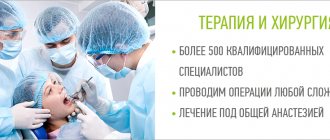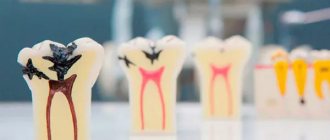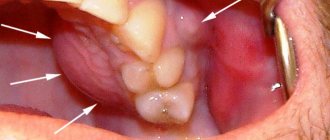Sometimes people are in no hurry to visit the dentist even when the tooth hurts noticeably. They prefer to endure it by swallowing painkillers. This removes the symptom, but significantly aggravates the cause of the pain – inflammation. And the consequences of such an independent “cure” always lead to a sad and predictable result: destruction of the pulp and purulent processes on the tooth roots.
Symptoms
Acute periodontitis is characterized by an attack of severe pain, during which swelling and swelling of the gums is observed, but the root top of the tooth is not yet destroyed. The chronic course of periodontitis practically does not manifest itself and is often asymptomatic; occasionally there is pain when biting. This stage of the disease can only be identified by contacting a dentist, who will make an accurate diagnosis using x-rays.
The acute form of the disease will not show any significant changes in the tooth area, but the chronic form will manifest itself in the appearance of a purulent sac, an abscess at the top of the root. In order not to cause damage to the oral cavity and save the tooth, long-term treatment will be required, which will take quite a lot of time, but it is also worth noting the fact that with modern medicine this process will be painless.
Causes of the disease
There are 3 main provoking factors that must act in a complex manner; none of them acts independently:
- Cariesogenic microflora - this includes Mutans streptococci, actinomycetes and certain types of lactobacilli. They should dominate the oral cavity. Bacteria produce organic acids from food carbohydrates, which cause demineralization of cement.
- Consumption of simple carbohydrates is the most cariogenic. Their breakdown produces glucan, which contributes to the appearance of plaque.
- Reduced caries resistance is a deterioration in the resistance of tooth tissue and the body as a whole. This is facilitated by a decrease in calcium content in hard root tissues, bad habits, and lack of saliva.
In addition, the anatomical features of the mouth can also have an effect - a small vestibule, a short frenulum, and bite pathology.
Gum disease, pocket formation
Gum pocket or otherwise periodontitis is a common occurrence in many patients. Many people do not treat it because it does not bother anyone for a long time.
The first manifestation of pathology is bleeding when brushing teeth, although outwardly they may look healthy. Dental pockets or depressions are normal, but their anatomical size should not exceed 3 mm.
Then the pocket is able to self-clean from food debris and epithelial particles. Reservoirs of bacterial accumulations form in deep gaps. This is accompanied by bad breath. Conventional treatment with antibiotics and brushing teeth with toothpaste have no effect.
Causes of periodontitis:
- insufficient hygiene;
- poor quality fillings;
- abnormal position of the dentition, malocclusion;
- hereditary predisposition;
- deficiency of vitamins and minerals;
- immunosuppression.
Treatment
When the pain can no longer be tolerated and medications do not help, you should immediately visit the dentist. When examining the patient, the doctor prescribes the necessary treatment, which will not be quick, but will lead to a complete recovery. The main goal of any dentist is to save the tooth.
During the initial examination, an x-ray is taken, with its help you can see the most complete picture of the disease. When the source of inflammation is found, you can begin to determine the form of the disease and treat the root. Today in dentistry, anesthesia is used not only for tooth extraction, as it was in Soviet times; modern drugs are mostly hypoallergenic, non-addictive, do not have a large list of contraindications, and can also be used in the treatment of children's teeth.
When treating a tooth root, the doctor ensures maximum comfort for the patient, anesthetizes the treatment site, then opens the tooth root and cleans it of purulent accumulation, then a special medicinal mixture is placed into the hole. Having covered the top with a special gasket, the doctor closes the tooth with a temporary filling.
Next, you need to wait a few days for the inflammation to subside. You need to wait about 5-7 days and take another picture to confirm that the inflammatory process has stopped. Next, the cleaned dental canals are re-filled and a new temporary filling is installed. Filling protects against new infections, which contribute to inflammation.
After three days, a final follow-up visit is made to the doctor, who, after examining the patient, making sure that there are no inflammatory processes and successful treatment, closes the tooth with a permanent filling and polishes it.
Subsequently, a restoration process occurs, during which the gums may still be sore, the tooth may even become loose, but after a while, the unpleasant symptoms will disappear. To avoid recurrent disease of the root of the treated tooth, the doctor’s appointment is repeated six months later.
What is the danger of this disease?
Caries is dangerous because there are no symptoms for a number of years. It is detected more often in an advanced stage, when tooth extraction becomes the solution.
Visual diagnosis is difficult because all destructive processes occur inside the tooth. Pronounced plaque or tartar hides any stains on the enamel.
The root is hidden under the gum and external irritants do not affect it until a certain time. On the other hand, the root walls are thin, so they are destroyed quickly and with complications.
How to relieve tooth inflammation
If inflammation of the root does not give you peace, then it is best not to delay a visit to the doctor. Traditional medicine at home is not intended to treat such a complex disease - we can say with confidence that self-medication will not bring the expected results. Relieving painful spasms and swelling with herbal infusions will only bring calm to the patient for a while, but the inflammatory process will develop and return after a while with more severe consequences.
The following will help to tame the pain for a while:
- Painkillers. They will help you endure acute pain, which is not advisable to endure, but it is best to drink them 12 hours before going to the doctor so that he can make a correct diagnosis;
- To relieve pain, you can rinse your mouth several times with a special solution, mixing a teaspoon of salt and soda in a glass of water, adding four drops of iodine;
- Using calendula tincture, you can relieve inflammation, mix a tablespoon of tincture with a glass of water, rinse your mouth up to 5 times;
- One of the modern recipes for relieving toothache: place two drops of propolis tincture on cotton wool and apply to the painful tooth, the pain should subside within an hour;
- Boil one teaspoon of chamomile and oak bark in a liter of water, leave for 20 minutes, cool slightly, rinse for inflammation;
It is important to remember that applying warm compresses to a sore spot is strictly prohibited! Rinsing and taking painkillers cannot be considered treatment, because even if you managed to relieve the pain, the inflammatory process has not been stopped, it will proceed unnoticed and will resume with renewed vigor, the consequences of which can be unpredictable.
Aimed Center - professional dental care
All types of dental services are provided by the Aimed clinic for residents of Moscow, Northern, Southern Butovo. The center employs doctors with many years of experience. Specialists provide therapeutic, surgical, endodontic, orthopedic, orthodontic treatment according to new European protocols. When treating tooth root inflammation and providing other services, we guarantee our patients:
- Complete painlessness of the procedure, use of proven, certified anesthetics;
- A comfortable clinic environment that is incomparable to hospital conditions;
- Use of new Japanese, American, European equipment for accurate diagnosis and treatment;
- Use of modern consumables, drugs from Israel, USA, Japan;
- Possibility of visiting the center from 08:00 to 21:00, seven days a week, holidays;
- Reception of patients of any age from the youngest to the elderly;
- Formation of favorable prices for all services without compromising the quality of the work performed.
- To make an appointment with a specialist, call +7 (495) 120-66-43. Clinic operators select a convenient time for your visit. And in the clinic’s parking lot there is always a free space for your car. We located at the metro station st. Gorchakova.
Remember, you should never ignore toothache. A minute of delay or self-therapy with folk remedies (rinses, compresses) threatens with serious complications!
Inflammation of a wisdom tooth
The location of this tooth in the oral cavity is sometimes difficult to reach for a doctor and is therefore considered the most difficult to treat. The wisdom tooth begins to erupt closer to the age of eighteen, which is why it received the name “comes with wisdom.” When it erupts, painful discomfort is felt, the reason is the absence of milk teeth in this place previously, so the incisor, growing, cuts through the gum. Swelling of the cheek and inflammation of the gums begins, which covers the area of the wisdom tooth; various symptoms may also appear, the lymph nodes become inflamed, swallowing becomes difficult, and the temperature rises.
A slight swelling can be considered normal, and the cause of the inflammatory process can be several factors:
- The wisdom tooth is looking for a place to come out, but not finding it creates inflammation in the gum and nerve;
- When the gums come out, there is not enough free space for normal growth, it begins to put pressure on the teeth in the neighborhood, which causes inflammation;
- The location of the growth of wisdom teeth depends on the structure of the oral cavity; if the shape is irregular, inflammation often occurs and cysts form.
To determine the presence of an inflammatory process in a wisdom tooth, you will need an x-ray; there are characteristic signs of inflammation:
- Sensation of unpleasant taste;
- Swelling of the gums around the tooth;
- The resulting pus spreads in the oral cavity, forming a pungent odor;
- When a wisdom tooth grows, the pain radiates to the temple or ear.
In this case, consulting a doctor is mandatory. If proper treatment is not started on time, it can lead to severe pain and many complications, the formation of purulent abscesses and phlegmons, which are subsequently resolved surgically.
Today, more and more dentists are of the opinion that the wisdom tooth does not need to be treated, but should simply be removed, because it's more trouble than it's worth. The complexity of treating its roots is determined by its location, and the doctor will make a decision in each individual case: to treat or remove a wisdom tooth.
Is it possible to cure pulpitis and how are nerves removed: types of anesthesia
As mentioned earlier, pulp inflammation is an extremely painful pathology, which primarily affects the nerve endings inside the oral cavity. The process of its treatment necessarily includes an operation to select a high-quality antiseptic that is suitable for a particular person. Moreover, the drug is applied to the desired places using various methods:
- application;
- infiltration;
- conductive;
- stem
The anesthetics used are traditional pairs of lidocaine and novocaine, as well as more advanced and modern formulations: Ultracaine, Ubistezin, Septanest, and so on.
Inflammation after tooth extraction - treatment
When there is no way to save a tooth, there is only one option left - to remove it. When removing, anesthesia is used, when its effect wears off, the tooth socket may ache, if the pain does not disappear within 2-3 days and painkillers do not help, most likely the inflammatory process of the tooth socket has begun. What could be causing it:
- Injury during tooth extraction;
- Foreign particles entering the hole cause inflammation;
- Improper hygiene;
- Infection in the hole.
To relieve inflammation after tooth extraction, you should not self-medicate; in this case, you should definitely consult a doctor.
Self-medication in this case can lead to the development of abscesses and sepsis. The doctor will correctly select the right antibiotic and dosage of the medicinal drug, an antiseptic solution for rinsing the mouth.
Preventive measures
Measures to prevent periodontitis are as follows:
- Regular and thorough oral hygiene using fluoridated toothpastes.
- Treat bacterial plaque (especially after eating) using dental floss, brushes, etc.
- A scheduled visit to the dentist (once every six months), who will promptly treat caries, remove tartar, and more.
- A healthy diet containing vitamins, complex carbohydrates, and beneficial microelements. All this is found in fresh vegetables and fruits, dairy products, protein-rich foods, etc.
- Minimize the consumption of preservatives and various artificial flavor enhancers, sugar-containing foods and drinks (especially soda).
And most importantly, do not start dental disease at the slightest manifestation. Untreated and extremely advanced forms of caries and pulpitis are the main cause of periodontitis.
Inflammation of the bone tissue of the tooth
The inflammatory process is the primary source of osteitis in the bone tissue of the jaw; if proper treatment is not provided in time, it will develop into periostitis (the periosteum becomes inflamed), osteomyelitis (the bone marrow becomes inflamed). With osteitis, pain is felt, the affected area swells, difficulties arise in chewing food, and the entire jaw gradually begins to ache. The cause of symptoms of osteitis is:
- Received traumatic actions, blows, bruises, jaw fracture;
- Surgical complication;
- tuberculosis and syphilis;
Treatment of osteitis occurs through surgery with the use of antibiotics and immunostimulating medications. Decaying teeth harbor bacteria and must be removed to prevent further inflammation. Patients with tuberculosis or syphilis first cure the underlying disease, then proceed to eliminate osteitis.
The slightest suspicion of pain in the bone tissue in the oral cavity is a reason to consult a doctor. Treatment of osteitis started in the first stage will make it possible to save teeth and protect against painful complications. Successful treatment depends on correct implementation of the dentist’s recommendations and careful oral care.
What provokes the inflammatory process
Periodontium is the connective tissue located between the cementum of the tooth and the alveolar plate. Inflammation of this tissue that forms the tooth root is called periodontitis. There may be several factors that trigger the pathogenic process:
- The consequences of advanced caries and pulpitis are infectious inflammation of root tissue.
- Incorrect treatment of pulpitis causes drug-induced periodontitis. It occurs due to the contact of potent medications (for example, arsenic) on the surface of the periodontium. Sometimes the root becomes inflamed due to an allergy to medications used to treat pulpitis.
- Jaw injuries (from blows, falls, regular microtraumas). The course of traumatic periodontitis is quite acute.
- Inflammation of the root tissues of the tooth can be a complication after sinusitis, other ENT pathologies or osteomyelitis (an extra-dental type of disease).
In addition, the reasons that cause inflammation of the peri-root tissues of the tooth include the following pathologies: rupture of the wall or the entire root cavity; lack of patency of root canals; cystic formations around the tooth root or already grown into the maxillary sinus; injury to root tissues when removing pins or core inlays. In severe advanced stages, with inadequate therapy, marginal periodontitis can be observed, in which the gums are also affected along with the root apex.
Lifestyle
If you have learned about the risk group for root caries (older age), this does not mean that you can relax. Caries has many causes and can occur at any age if basic precautions are not followed.
Those at risk include smokers, diabetics, pregnant women and even children. The provoking factors in this case are:
- smoking and lack of oral hygiene;
- infrequent brushing of teeth and lack of fluoride;
- poor nutrition with preference for desserts;
- frequent stress;
- alternating hot and cold;
- structural features of the oral cavity;
- alcohol abuse - alcohol breaks down into sugars and acids;
- abuse of coffee and strong tea, which creates an acidic environment in the oral cavity;
- lack of water intake, and therefore lack of saliva;
- gum injuries.
Diagnosis of the disease
The diagnosis is made in stages. Listening to complaints and visual examination make it possible to diagnose caries only in 13% of cases. Classic probing with a sharp probe and inspection with a mirror are informative. This allows you to examine the dentition.
Thermal diagnostics, electroodontometry and x-rays are also performed. If the patient has massive dental plaque, changes in the enamel will not be visible. In this case, professional teeth cleaning is first carried out to remove plaque and stone. All this is possible in a dental clinic.
At the dental clinic
The following types of studies can be performed at the clinic:
- Probing with a thin probe with a curved end - it is inserted under the gum, while the doctor has the opportunity to examine the structure of the tooth, its integrity, the presence of irregularities and chips. With rapidly progressing caries, the edges of the cavity are uneven and sharp. In the remission stage, the surface of the pathological focus is shiny, smooth, hard with smooth edges.
- Electroodontometry - can determine nerve damage and the depth of inflammation. The pulp reacts differently to the current strength.
- Thermal diagnostics - treatment of different areas of the tooth with a stream of water and heated wax. Unpleasant sensations that disappear after removing the irritant indicate caries.
- X-ray - a targeted photograph of one tooth or computed tomography. The presence and localization of obvious or hidden inflammation is determined with millimeter precision.
- Visiography is a special device - a visiograph scans the received data and transfers it to a computer, where the picture is studied from different angles and in detail, revealing the hidden process of inflammation.
Cleaning in dentistry from stone and plaque
1243900247100
Professional teeth cleaning involves removing the accumulation of all pathogenic microflora around the root.
It involves not only removing plaque, but also stones. This elimination of negative factors protects teeth for a long time.
Antiseptic treatment of affected areas
Treatment of root caries involves drilling out all affected areas with a drill and treating the carious cavity with antiseptics and special preparations. A 2% chlorhexidine solution or a gel based on it is used as an antiseptic for the treatment of carious cavities.










